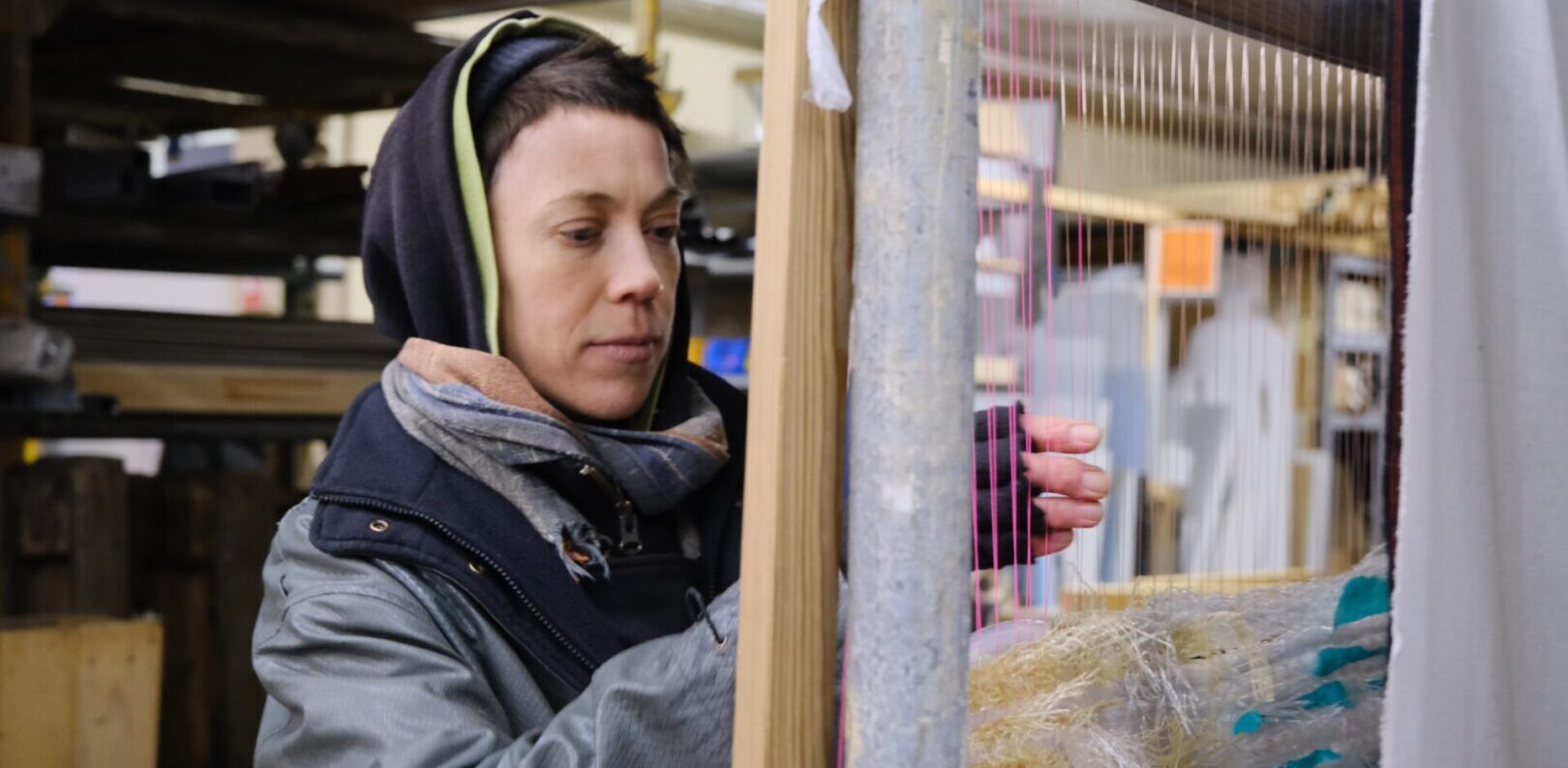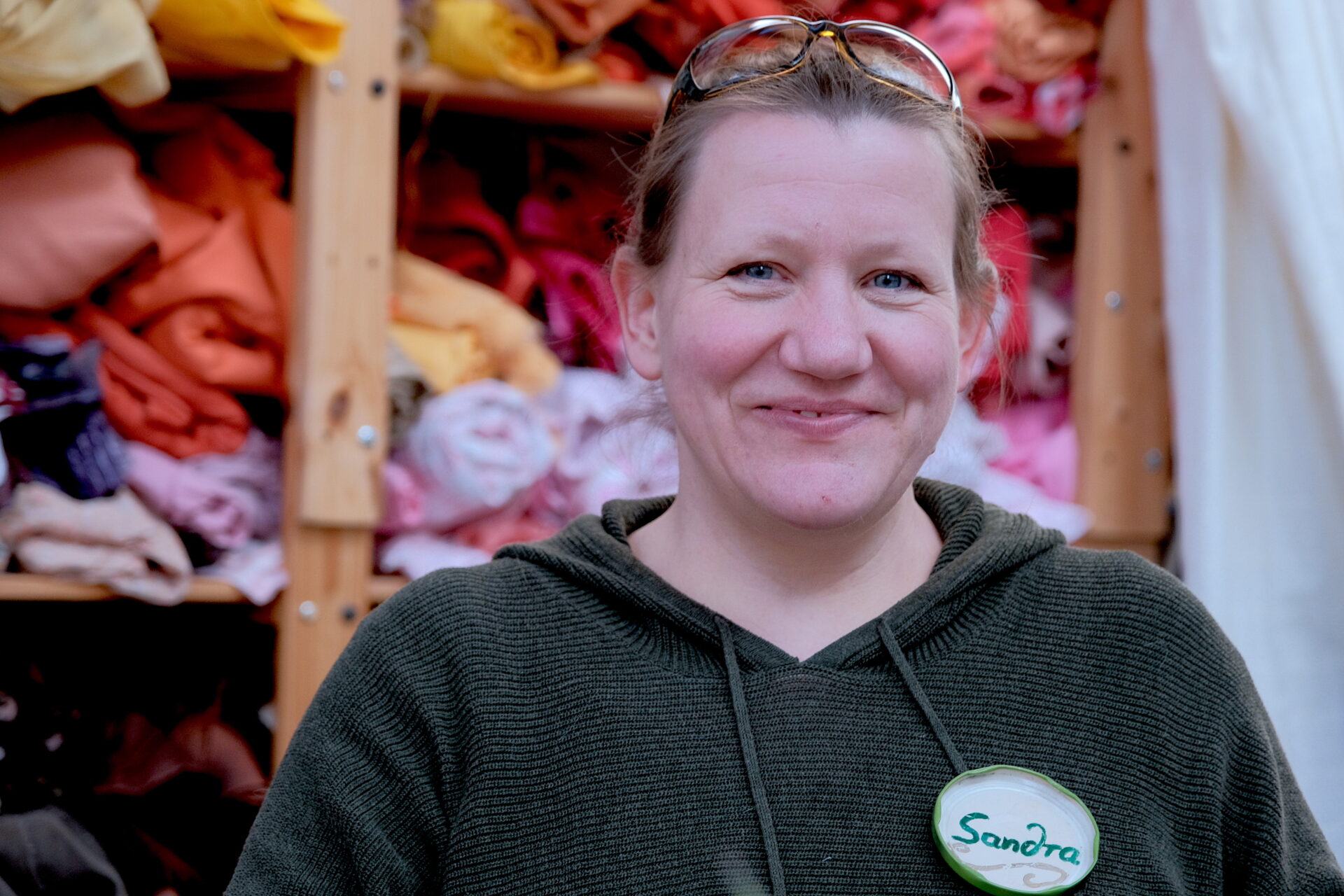The current dominant narrative encourages us to overconsume, produce an incredible amount of waste, and detach ourselves from all responsibilities. Abandon, discard, import, export… If this is the story that has been told to us for decades, it is time to be among the people who are shifting the narrative. Cyril Dion, Rob Hopkins, Avant l’orage, Alain Damasio, and many others share, through culture and art, new narratives to inspire, witness, and inform. Art and culture have always been means of expression throughout history, of shifting our perspective, and of opening our eyes to the state of the world.
Throughout our journey, we wanted to take the opportunity to give voice to a Berlin-based artist. How to reconcile art and circular economy? In its report Circular Economy and Culture (2021), Orée association indicates that despite an awareness of « its ability to change behaviors, the cultural sector has recently become aware of the issues of the circular economy and is gradually committing to applying its principles. »
In February 2023, in Berlin, we met Upsidogi Son Sea, from the United States, where she received a Bachelor of Fine Arts, specialising in weaving, from Massachusetts College of Art and Design in 2008. She came to Berlin that same year for an artist residency. Then she decided to returned to Berlin in 2009 where she created various installations and projects before returning to weaving different materials during the Covid period. We met her at the second-hand building materials store Kunst Stoffe and were able to exchange with her. Here is the story of our exchange.
What is the « Transformation Station » project?
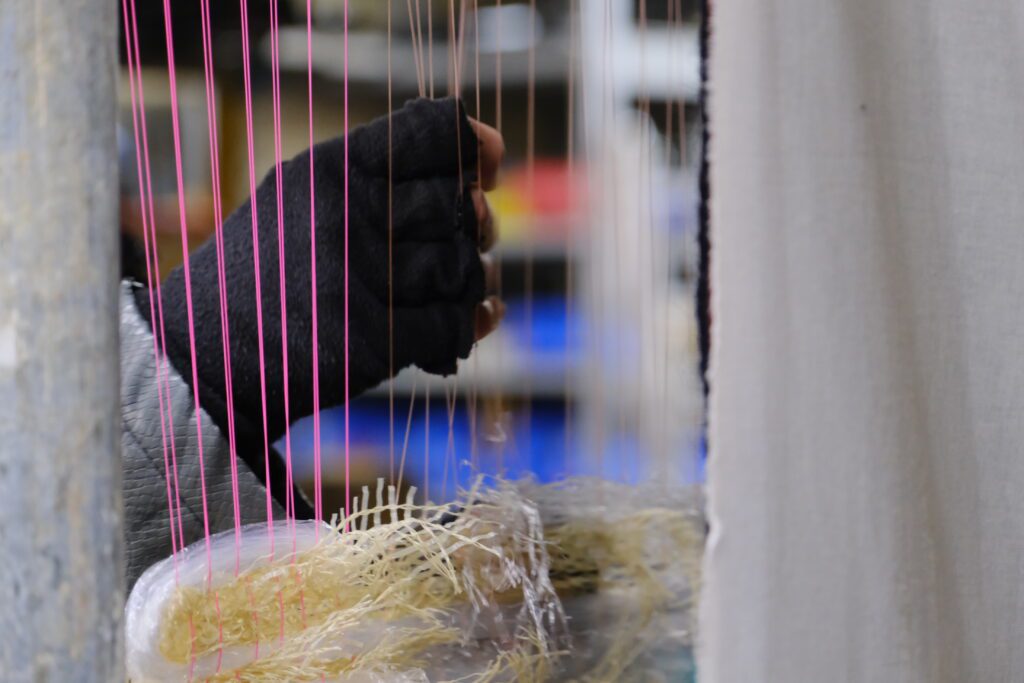
Initially, I contacted Kunst Stoffe and proposed the idea of holding a weaving workshop here with the aim of showing people how they can make their own looms. It’s a really accessible process. I believe that anyone can learn it, and it is part of most cultures. I think it’s a really important process to put in the hands of as many people as possible. It’s also a way to use a lot of surplus materials, such as fabrics – because there is such an overproduction of fabrics – as well as other materials and waste.
I mainly use packaging materials that I collect from various stores around Berlin, and my goal is to save as much material as possible from the local waste system and turn it into weavings.
What I love about the weaving process is that you don’t necessarily need to have a specific image or plan in mind. You can just weave organically and see what happens. Or you can weave with other people – each of you can weave a line or you can weave for 10 minutes or for hours and hours.
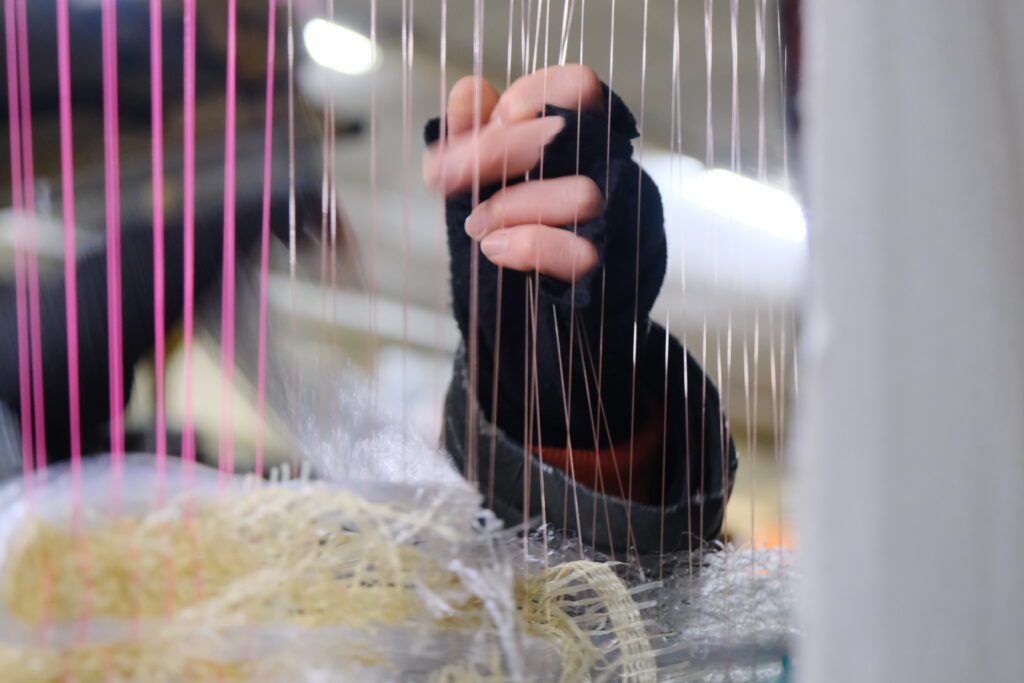
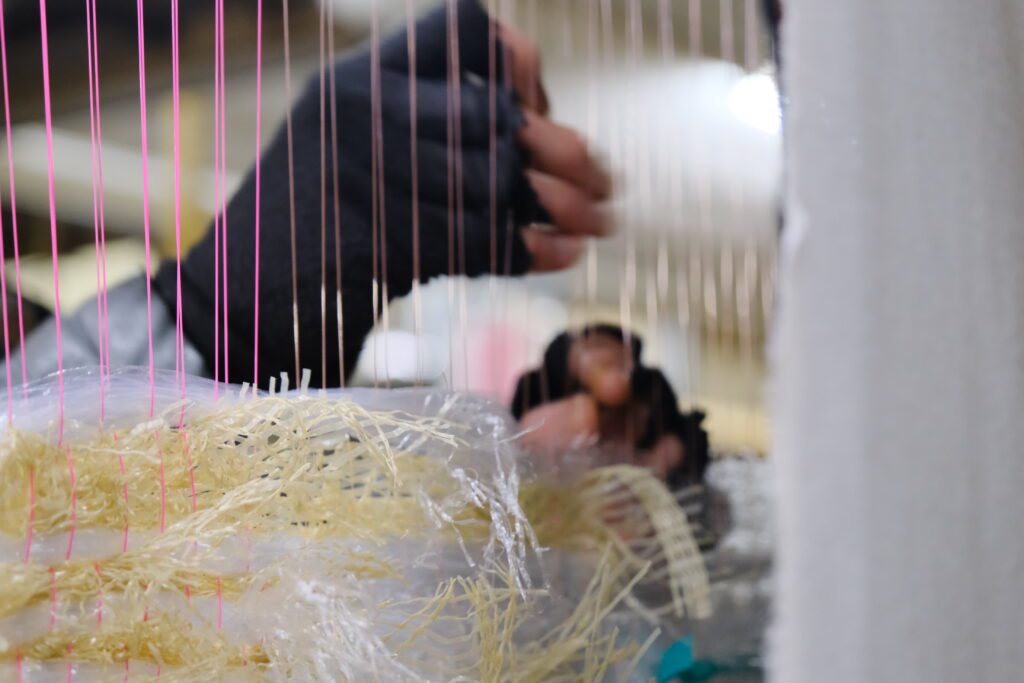
It’s a process that is very enjoyable to combine with other people, or it’s also enjoyable to have at home, so it’s very flexible and I think it’s a great tool for giving back what I think is an important human skill, creativity, to as many people as possible. Because I don’t think it’s something that only artists should be allowed to do, being creative. People are often afraid to try to start something creative, they think: « I can’t do it » or « I don’t know how to do it »…
Transformation Station is a very democratic process in that sense.
How did you decide to use waste in your creative process?
I have always tried to use non-toxic materials. For a long time, I used old paper. And then with weaving, I don’t remember exactly how I came up with the idea of using packaging materials and other things. I’m also engaged as an environmental activist, and I wanted to combine the two. So instead of just using non-toxic materials, I decided to take it a step further and make the purpose of creating art to be about using waste from the system.
And when I started thinking about it and using plastics, I realized it was great because right now it’s an endlessly produced material. I never had to buy any. And working with plastic and weaving it gives a really nice texture. It’s quite interesting to compare how different plastics combine together, and sometimes they really look like wool or cotton depending on how they’re cut. The more varieties there are, the more interesting the textures are for me.
Do you consider plastic and all the materials you use for your pieces as waste?
I’m trying to transform this idea of what I see as waste in our current society. In fact, we have so much access to these materials, and if we change the way we think about them, how we perceive them, they are no longer waste. They are actually, like here, a material to make something but also a material to teach other people how to make things.
So I don’t see these plastics as waste. But by approaching the material in a different way, by trying to get other people to reconsider the things that pass through their lives every day and help them imagine how to change the relationship they have with them instead of just throwing them away.

How much does one of these Transformation Station works cost?
I think that’s an interesting question. I sell my works in terms of hours of manual labor. I don’t really believe in the idea of the artist with an oversized ego whose works necessarily cost a lot because they were created by a genius. Of course, I have created productions – especially drawings – that took me only a few hours and are really good. This work is certainly worth much more than those hours. But with this « Transformation Station » project, what I’m doing is keeping track of the hours it takes. Then when someone is interested in buying a production, it works like solidarity prices for going to parties or sometimes even in cafes. That is, the person pays what they can. I tell the person how many hours it took me to make the artwork and then I indicate the amount of the solidarity price – from 10 to 20 euros per hour – so that the buyer can decide how much to pay. I hope this is a way to make art more accessible. But it’s also a way for them to understand what we do with our hands, what manual labor is, what art is… It’s just another way of getting people to change their mindset about these issues.
Do you think that artists have a role to play in raising people awareness about the issues of our century such as climate change ?
Yes, I believe that many artists use their work to inspire changes in people’s behavior or raise awareness about social issues, but not all artists do so. When we look at art supply stores and the production of art materials, we can see that it is an extremely polluting industry, such like the fashion industry, for example.
The fashion industry is very polluting, which is why I am interested in using what we have rather than buying new materials.
I think that we, as artists, have this tool of creative thinking and creative problem-solving. The more we use it, the more we become trained, and the way we solve problems throughout the day can really change. Right now, we have so many huge problems – climate change, waste already produced and how it ends up in the environment – that we can wonder how we are going to manage it all. In my opinion, if more artists apply their creative thinking to these problems, I think it’s a beautiful way to solve problems together. In a fun way. It really is like a positive reinforcement, where we start working together by doing things. This way, people begin to think in a different way. I think this could have an exponential effect on how we could get through these crises. So a big YES.
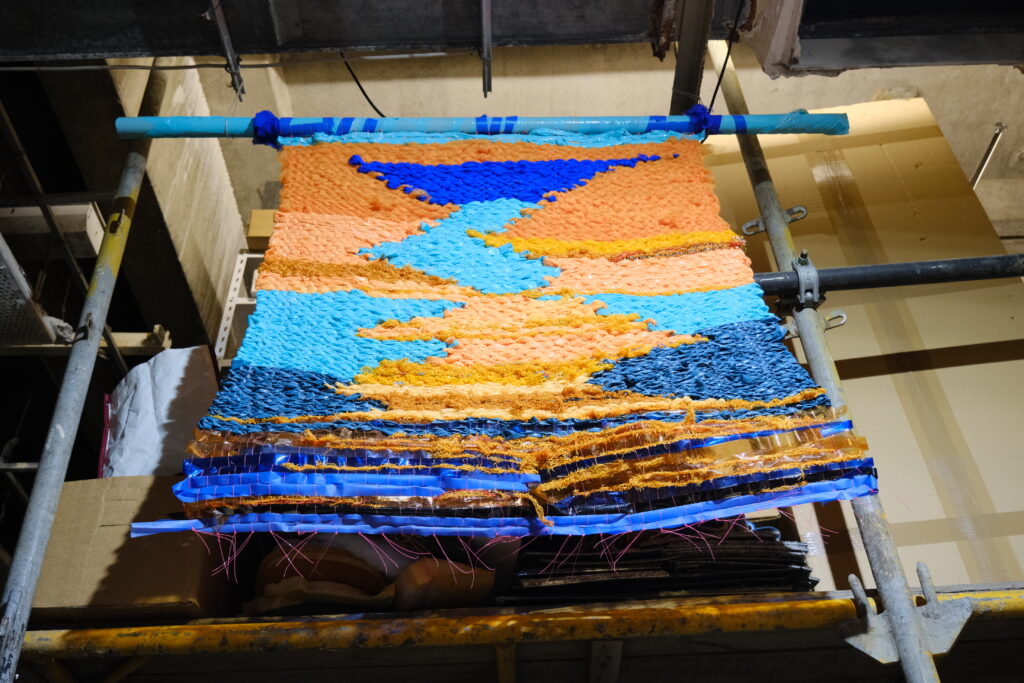

We are very grateful to Upsi for taking some time to speak with us about her work. Her inspiring reflection invites us to think in a completely different way about how to make art accessible:
- by producing it in a public place, within an alternative venue such as the House of Materials where we met her.
- by sharing knowledge, by offering to teach how to create one’s own loom, but also by inviting people to contribute to the piece for a few minutes or hours.
- by rethinking the way artistic productions are sold, involving the buyer in its acquisition, increasing the value that they can attach to it.
This exchange also opens up horizons on how to find solutions to the problems of our century. While not everything can be solved by having fun, why not try to draw on as many small tricks as possible to put the creative thinking present in each of us into action and make it grow? This may invite us to see certain things considered today as constraints, as a game, a new narrative. For example, producing a weaving from plastic waste with your entire family.
We hope that you enjoyed this exchange. We certainly loved the little spark that shone in Upsi’s eyes when she talked about her project.
We hope you enjoyed this ARTICLE about our meeting with Upsidogi Son Sea. Feel free to come and discuss it with us in the comments or on our social networks.
Find all our articles HERE !

